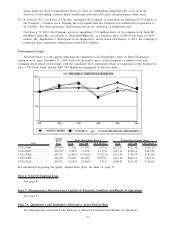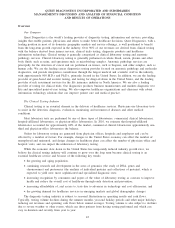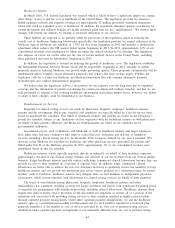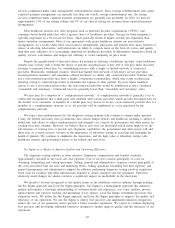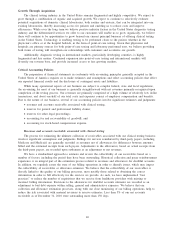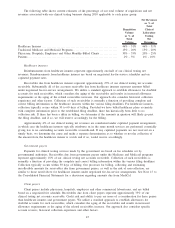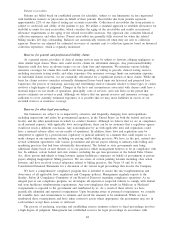Quest Diagnostics 2010 Annual Report Download - page 48
Download and view the complete annual report
Please find page 48 of the 2010 Quest Diagnostics annual report below. You can navigate through the pages in the report by either clicking on the pages listed below, or by using the keyword search tool below to find specific information within the annual report.services reimbursed under other arrangements with healthcare insurers. Since average reimbursement rates under
capitated payment arrangements are typically less than our overall average reimbursement rate, the testing
services reimbursed under capitated payment arrangements are generally less profitable. In 2010, we derived
approximately 13% of our testing volume and 4% of our clinical testing net revenues from capitated payment
arrangements.
Most healthcare insurers also offer programs such as preferred provider organizations (“PPOs”) and
consumer driven health plans that offer a greater choice of healthcare providers. Pricing for these programs is
typically negotiated on a fee-for-service basis, which generally results in higher revenue per requisition than
under capitation arrangements. Most of our agreements with major healthcare insurers are non-exclusive
arrangements. As a result, under these non-exclusive arrangements, physicians and patients have more freedom of
choice in selecting laboratories, and laboratories are likely to compete more on the basis of service and quality
than they may otherwise. It is increasingly important for healthcare providers to differentiate themselves based on
quality, service, convenience and unique test offerings to avoid competing on price alone.
Despite the general trend of increased choice for patients in selecting a healthcare provider, some healthcare
insurers may actively seek to limit the choice of patients and physicians if they feel it will give them increased
leverage to negotiate lower fees, by consolidating services with a single or limited network of contracted
providers. Historically, healthcare insurers, which had limited their network of laboratory service providers,
encouraged their members, and sometimes offered incentives, to utilize only contracted providers. Patients who
use a non-contracted provider may have a higher co-insurance responsibility, which may result in physicians
referring testing to contracted providers to minimize the expense to their patients. In cases where members
choose to use a non-contracted provider, the non-contracted provider would be reimbursed at rates considered
“reasonable and customary.” Contracted rates are generally lower than “reasonable and customary” rates.
We also may be a member of a “complementary network.” A complementary network is generally a set of
contractual arrangements that a third party will maintain with various providers which provide discounted fees for
the benefit of its customers. A member of a health plan may choose to access a non-contracted provider that is a
member of a complementary network; if so, the provider will be reimbursed at a rate negotiated by the
complementary network.
We expect that reimbursements for the diagnostic testing industry will continue to remain under pressure.
Today, the federal and many state governments face serious budget deficits and healthcare spending is subject to
reductions, and efforts to reduce reimbursements and stringent cost controls by government and other payers for
existing tests may continue. However, we believe that as new tests are developed which either improve on the
effectiveness of existing tests or provide new diagnostic capabilities, the government and other payers will add
these tests as covered services, because of the importance of laboratory testing in assessing and managing the
health of patients. We continue to emphasize the importance and the high value of laboratory testing with
healthcare insurers and government payers at the federal and state level.
Six Sigma as a Means to Improve Quality and Operating Efficiency
The diagnostic testing industry is labor intensive. Employee compensation and benefits constitute
approximately one-half of our total costs and expenses. Cost of services consists principally of costs for
obtaining, transporting and testing specimens. Selling, general and administrative expenses consist principally of
the costs associated with our sales and marketing efforts, billing operations (including bad debt expense), and
general management and administrative support. In addition, performing diagnostic testing involves significant
fixed costs for facilities and other infrastructure required to obtain, transport and test specimens. Therefore,
relatively small changes in volume can have a significant impact on profitability in the short-term.
We intend to become recognized as the quality leader in the healthcare services industry through utilizing
the Six Sigma approach and Lean Six Sigma principles. Six Sigma is a management approach that enhances
quality and requires a thorough understanding of customer needs and experience, root cause analysis, process
improvements and rigorous tracking and measuring of key metrics. Lean Six Sigma streamlines processes and
eliminates waste. We utilize the Six Sigma approach and Lean Six Sigma principles to improve the quality and
efficiency of our operations. We use Six Sigma to deploy best practices and implement initiatives designed to
reduce the cost of our operations and to provide a better customer experience. We expect to continue deploying
best practices and developing additional initiatives designed to further improve quality and the efficiency of our
operations.
45


